The goal of Muzzle Brakes & Compensators for the AR 15 is to reduce the vertical movement and recoil that inevitably takes place when you fire your rifle. While this might sound rather straightforward, trust me, there is a lot that goes into why this works, how this works, and why some models work better than others.
To prove that point while also giving you, the reader, a “leg up” on your AR 15 compensator shopping, we’ve tested and reviewed eight of the most popular models on the market. From recoil and side blast data to reticle movement and decibel readings, we’ve taken a lot into account when presenting this information.
Table Of Contents
Difference Between AR-15 Muzzle Brake vs Compensator, and Flash Hider
First things first: let’s clear up the definitions we’ll be using throughout the rest of this article.
- Muzzle Brake – Designed to reduce the recoil you, the shooter, feel. This is typically done via side vents.
- Compensator – Designed to reduce vertical movement via holes largely placed on top of the unit.
- Flash Hider – Designed to reduce the amount of muzzle flare when you fire your rifle.
What We Tested
When looking at any of these items, the first thing you need to consider is the size of the exit holes. In the case of brakes and compensators, the exit holes will be about the same size as the rifle round. Flash hiders have larger holes, allowing space for the unburnt powder to burn off. Keep this in mind any time you look at a muzzle brake device. We also tested:
Recoil
This is the main reason why muzzle brakes & compensators exist. To test it, we simply filmed ourselves firing and measured the amount of horizontal and vertical movement with each shot.
Side Blast
This refers to the amount of energy expended sideways when the weapon fires. To test this, we put a windsock next to the firing position and took note of its reaction. The more side-blast the weapon put out, the more the windsock would move. This could give us a rough idea of how comfortable or uncomfortable a shooter standing next to you would be.
Decibel Readings
The funny thing about reducing recoil and vertical movement are that all that energy has to go somewhere. One of the places it goes is called side blast (see above). However, it might also be converted into sound. That’s why we tested the decibel level with each different unit.
Reticle Movement
Being able to reacquire the target after your first shot is an essential part of effective shooting. By filming through the scope itself, we were able to measure just how much the reticle moved off the target with each shot. In theory, this would give you a good idea of how long it might take to get in position for a second shot.
Top AR 15 Muzzle Brakes & Compensators
1. A2 Birdcage Muzzle Brake
If you have a stock AR-15, this is likely already attached to the front of it. Though I recommend this over nothing, it’s more of a “control” muzzle with which we can better compare the other products on this list. In terms of flash reduction, we only got .48 Lux as opposed to over 10,000 Lux for the bare muzzle.
Recoil: The recoil wasn’t really affected much. Overall, it felt pretty standard.
Side Blast: Not a lot of movement in the windsock as I fired. More or less like any other rifle on the range.
Decibel Readings: Around 118.8 dB – about as loud as a thunderclap.
Reticle Movement: Pretty serious movement up and to the left. My measurements put the distance it moved from the target at well over an inch (scope view).
With the extremely low cost (around $13) and reasonable effectiveness, there’s no reason to ignore the Birdcage Muzzle Brake. Just remember that it’s only slightly better than nothing at all.
2. Battlecomp 1.0 Muzzle Brake
The BattleComp 1.0 had its day in the sun not long ago, and it remains a popular option among shooters from a wide range of backgrounds. At around $155, it’s a pretty big jump in price from the Birdcage. We can only hope that the performance is there to back up the cost.
Recoil: Recoil seemed fairly evenly distributed throughout the rifle.
Side Blast: More movement than we saw with the A2, but not by a lot.
Decibel Readings: Around 117 dB on average, which is barely discernable from the A2.
Reticle Movement: Unfortunately, the reticle moved to 11 o’clock by about two inches this time. That’s an unacceptable amount for me, as it will drastically increase target reacquisition time.
The flash suppression was a bit higher here, reaching around 1.41 Lux. Still, I can’t get past the reticle movement. For this price, there just isn’t enough of a difference to justify purchasing this instead of the trusty A2.
3. DPMS Miculek Compensator
The DPMS Miculek Compensator gets a lot of attention because it was designed by the world’s fastest shooter. According to reports, it can reduce recoil by a full 68%, which isn’t bad at all. That said, this one has a reputation for putting out quite a bit of side blast, so let’s see how she does on the range.
Recoil: The claims about recoil control were definitely true. The energy distribution felt really even as I moved from shot to shot.
Side Blast: There was a lot of windsock movement here. Probably not the most pleasant rifle to be shooting next to at the range.
Decibel Readings: This one only clocked in at about 117 dB, which is perfectly in line with our control muzzle.
Reticle Movement: There was more reticle movement than with the M4-72 listed below, but not by much. The only weird thing was that the movement was towards 9 o’clock instead of 12 or 11.
A great choice considering the $50 price tag. It’s a bit heavier (3.3 oz), but the performance benefits are pretty clear.
4. Precision Armament M4-72 Severe Duty Compensator
According to the manufacturer, M4-72 can reduce recoil by up to 74%. That’s a bold claim, but it’s a pretty bold piece of equipment as well. The design of the unit itself is fairly aggressive, with side cuts that resemble fish gills carved deep into the metal. Let’s see how she performs on the range.
Recoil: The recoil reduction was very noticeable. It seemed more like the rifle was vibrating than moving in any one direction.
Side Blast: The side blast was pretty sufficient on this one – a byproduct of those aforementioned aggressive cuts. The windsock definitely got a ride from this compensator.
Decibel Readings: Around 120 dB – same as working a chainsaw.
Reticle Movement: The M4-72 absolutely killed it in the reticle movement department. I barely measured a .5” movement.
For about $100 and a little bit more side blast, you can all but eliminate reticle movement from shot to shot. If accuracy is your game, I highly recommend the Precision Armament M4-72 Severe Duty Compensator.
5. Ascend Armory Titanium Brake Mod 1
This all-titanium brake and compensator hybrid feature both side and top holes. Not only does it look cool, but it is a fraction of the weight of its steel counterparts. It’s not a budget model, however, and will set you back between $80 and $100, depending on the website.
Recoil: The recoil felt very evenly distributed. I didn’t get the sense that the rifle was pulling upward or away from the target with each shot.
Side Blast: The windsock looked like it had been gut-punched with this one. The movement itself was reduced, but the impact was sharper. Stand in the wrong place, and this one might cause you a good ring in the ears.
Decibel Readings: The Mod 1 only put out about 115 dB, which is the least so far. In terms of comparison, this is about as loud as a rock concert.
Reticle Movement: We saw the reticle move about .75” towards 10 o’clock. Not a deal-breaker, but not ideal either.
You won’t be the first person to skip out on a component because of the material, but I do have to say that the titanium Brake Mod 1 holds up very well here. Unless you need that extra weight on the end of your barrel, you should be plenty happy with this design.
6. Strike Industries J-Comp V2 Muzzle Brake
Pricing out at about $30-$40, you could do a lot worse than the Strike Industries J-Comp V2. Not only does it offer a 1.44 Lux flash reduction, but the recoil reduction has been rated a fairly decent 61%.
Recoil: I noticed a decent pull upward as the rifle recoiled, but it was followed by a more even distribution from the tip of the rifle to the butt, which minimized the movement.
Side Blast: I would not want to be next to this rifle on the range. To my eye, the windsock looked like an invisible ninja had kicked it.
Decibel Readings: Around 118.8 dB – standard as far as what we’ve seen so far.
Reticle Movement: The photos of the reticle movement did indeed indicate an upward pull to 10 o’clock. Though a little less than an inch, it was still noticeable when I went to realign my shot.
I like the low price of the J-Comp V2, but I wasn’t completely floored by its performance. That said, If you have to get a muzzle brake, you could do a lot worse. In fact, it’s a pretty good “all-around” option that most shooters will enjoy.
7. VG6 Gamma Muzzle Brake
This little device has been rated with a respectable 66% recoil reduction, which puts it all the way up there with the Miculek’s 68%. It’s much more compact and light, however, which some shooters will love.
Recoil: The recoil was greatly reduced, as advertised, but I again felt myself being pushed towards 7 o’clock rather than pulled up towards 10 or 11. This might throw some shooters off.
Side Blast: The windsock had the same “gut punch” movement that we saw with Mod 1. Still, it didn’t seem extreme enough to warrant warning the guy next to you.
Decibel Readings: The sound was cut down pretty well here, with only about 116 dB cutting through.
Reticle Movement: The downward recoil I described definitely showed up in the reticle movement. I’d say it we traveled about .75” down and to the left here. This was likely due to the vertical vents. Even if the sensation was odd, regaining the target was still pretty easy.
If you want a good budget muzzle brake that performs like the ones that cost 30% more, this is your best bet. It’s also worth noting that the Gamma weighs in at only 2.1 oz, so it’s not going to weigh down your rifle.
8. Nero 556 Muzzle Brake
If this little muzzle brake looks a little different from the rest, it’s likely due to the fact that it is 3-D printed out of high-quality Inconel. Since it’s not made of steel or titanium, there are a number of intricacies in the design that you just can’t get anywhere else.
Recoil: The recoil here was very unique as if the rifle were pulling to both sides. Still, it was greatly reduced when compared to our control muzzle.
Side Blast: The side blast was actually visible here, even if the windsock didn’t reach as much as it did with the Miculek or M4-72.
Decibel Readings: There was a slight noise reduction, bringing the shot volume down to a respectable 117.6 dB.
Reticle Movement: Another instance of the reticle moving downward with each shot. In this case, it moved about .25” to 8 o’clock.
The movement may be unorthodox, but it’s perfectly reasonable as far as I’m concerned. Though the Nero 556 will set you back nearly $200, its performance is well worth the cost.
AR-15 Muzzle Brakes & Compensators FAQs
Some of the most common questions around Muzzle Brakes & Compensators for an AR-15.
What is the difference between a muzzle brake and a compensator for an AR-15?
A muzzle brake and a compensator each have different functions. The muzzle brake’s primary role is to reduce the recoil of your AR-15. It achieves this by redirecting gases caused by firing the bullet to the sides, making the gun experience less backward force. On the other hand, a compensator mitigates muzzle rise, i.e., the upward motion of the firearm after firing. This is achieved by directing the gases upward, helping to keep your gun level.
Do muzzle brakes and compensators affect the accuracy of an AR-15?
Generally, muzzle brakes and compensators won’t degrade the accuracy of your firearm. Quite the opposite, in fact. By reducing recoil and muzzle rise, they can enhance your control over the firearm, facilitating repeated accurate shots. However, it’s crucial to get a brake or compensator correctly installed to avoid any adverse effects on accuracy and performance.
How do I choose between a muzzle brake and a compensator for my AR-15?
The choice between a muzzle brake and a compensator depends on your shooting needs and personal preference. If you’re particularly sensitive to recoil or often fire powerful rounds, a muzzle brake might be the better option. If your main challenge is muzzle rise and keeping your shot level, a compensator will likely serve you better. Remember to also consider the additional factors like noise increase, comfort, and overall firearm performance when making a choice.
Does installing a muzzle brake or compensator require professional assistance?
While it’s possible to install a muzzle brake or compensator yourself if you have the required tools and confidence in your ability, it’s often recommended to get professional assistance. Incorrect installation could not only affect your shooting but could also potentially damage your firearm or make it dangerous to operate.
Will adding a muzzle brake or compensator to my AR-15 make it louder?
Yes, typically adding a muzzle brake or compensator can make your AR-15 sound louder. This is because they function by redirecting gases, which can cause sound waves to travel in different directions, including back towards the shooter. Therefore, always protect your hearing when shooting, especially when using muzzle devices like brakes or compensators.
Muzzle Brakes & Compensators for AR 15 – Conclusion
Here’s how all the muzzle brakes and compensators data breaks down:
The best overall compensator was the M4-72 Severe Duty. It greatly reduced recoil while displaying the least reticle movement between shots. Just keep in mind that the people standing next to you will probably hate it.
The runner-up is the DPMS Miculek Compensator, which demonstrated similar results but costs half as much. So if you’re watching your wallet or looking to outfit multiple rifles, this is the option for you.
The best hybrid is the VG6 Gamma muzzle brake. It put some serious downward force on the reticle, but I can’t complain about how it held up on the range. It’s also lighter than the other options, which is a love it or hate it feature for most shooters.
The most futuristic model (and the one with the most promise, IMO) goes to the Nero 556 muzzle brake. I, along with many other gun owners, is paying a lot of attention to 3D printing technology. If it improves further, we might someday be designing and printing our own muzzle brakes.
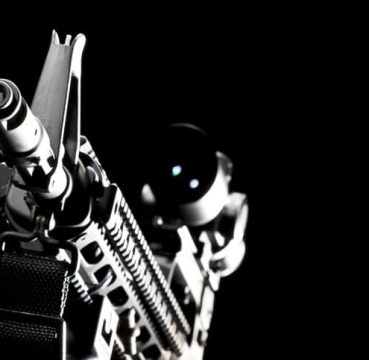


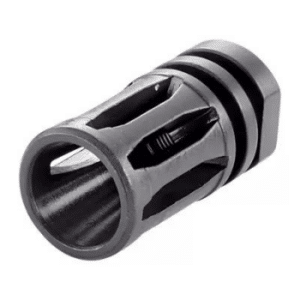
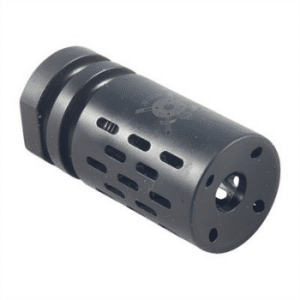
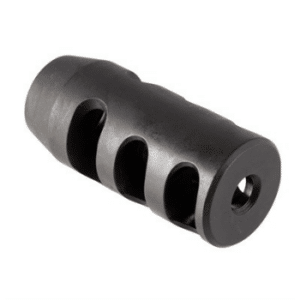
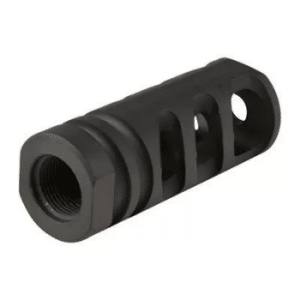
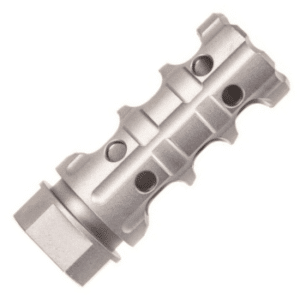
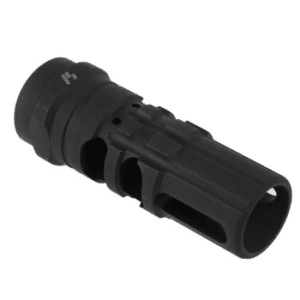
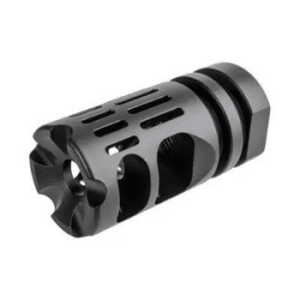
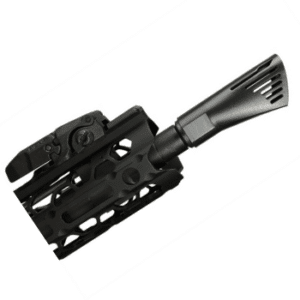









One Response
Is there enough of a benefit, or advantage, to the M4-72 Severe Duty to justify twice the price as the DPMS Miculek compensator?